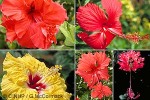Cook Islands Biodiversity Database
Species Page
Hibiscus rosa-sinensis
Kaute / Kaute ‘EnuaRed Hibiscus
Multimedia & Additional Resources
| Type | Description | Download |
| Flowers - the basic forms | 65KB | |
| Polynesian introduced varieties | 58KB | |
| 1750 specimen from SriLanka (large double) | 70KB | |
| 1769 specimen from Tahiti (small scarlet double) | 57KB | |
| Polynesian cultivar - large form | 66KB | |
| 'Sports' Varieties | 102KB |
General Information
Cook Islands Distribution
| Southern Group: Present Makatea: Present | ||||||||
RR |
MG |
AT |
MK |
MT |
AK |
PL |
TK |
MN |
++++ |
++ |
++++ |
++++ |
+++ |
P |
- |
||
| Northern Group: Present | |||||
TN |
MH |
RK |
PK |
NS |
SW |
++ |
++? |
++? |
+ |
P |
P |
Pests & Hosts
| Relationship | Pests |
| Herbivorous pest | Adoretus versutus, |
| Pathogen | Aceria hibisci, |
Scientific Taxonomy
Hibiscus rosa-sinensis Linnaeus
TAXONOMY: PLANTAE; ANTHOPHYTA (=Angiospermae); MAGNOLIOPSIDA (=Dicotyledones); DILLENIIDAE; Malvales; MALVACEAE
More Information
GENERAL NOTE: The two or three forms of the Scarlet-double Hibiscus were introduced by the early Polynesian settlers. The largest form is common in the mountains of Rarotonga and in gardens, and on the Southern Group Outer Islands; the smallest form is in gardens and is similar to the form collected in Tahiti on Captain Cook's first voyage; the third form is intermediate in size, has petals with shallow lobes, grows in gardens, and it may also be an ancient introduction. The Single-red Hibiscus is a common hedge plant and is an early post-European Contact introduction. There is some evidence that this form was derived from the form with the terminal petals and or the Fringed Hibiscus. The Fringed Hibiscus, long considered a different species, is now known to have arisen as a mutation (="sport") on a plant of Hibiscus rosa-sinensis. The many other forms of Hibiscus are all bred cultivares. The longer lasting, firm petalled forms are often called Hawaiian cultivares because several were bred in those islands.
Vouchers & References
Vouchers:
Pukapuka: fieldspecimen, 2/2004, single-red only, rare in villages, ID GMcC.
References:
p.556 Neal - In Gardens of Hawaii
p.629 Tropica
p.2/419 A.C.Smith - Flora Vitiensis Nova
p.274 A Cheeseman - Flora of Rarotonga
p.72 Wilder - Flora of Rarotonga
p.368b Whistler - Ethnobotany of the Cook Islands
p.56 McCormack/Kunzle - Rarotonga's Mountain Tracks and Plants
Data Update History (information):
zTX, zB02, zM02, zD05a
Web Resources
Citation Information
McCormack, Gerald (2007) Cook Islands Biodiversity Database, Version 2007.2. Cook Islands Natural Heritage Trust, Rarotonga. Online at http://cookislands.bishopmuseum.org. ![]()
Please refer to our use policy.

